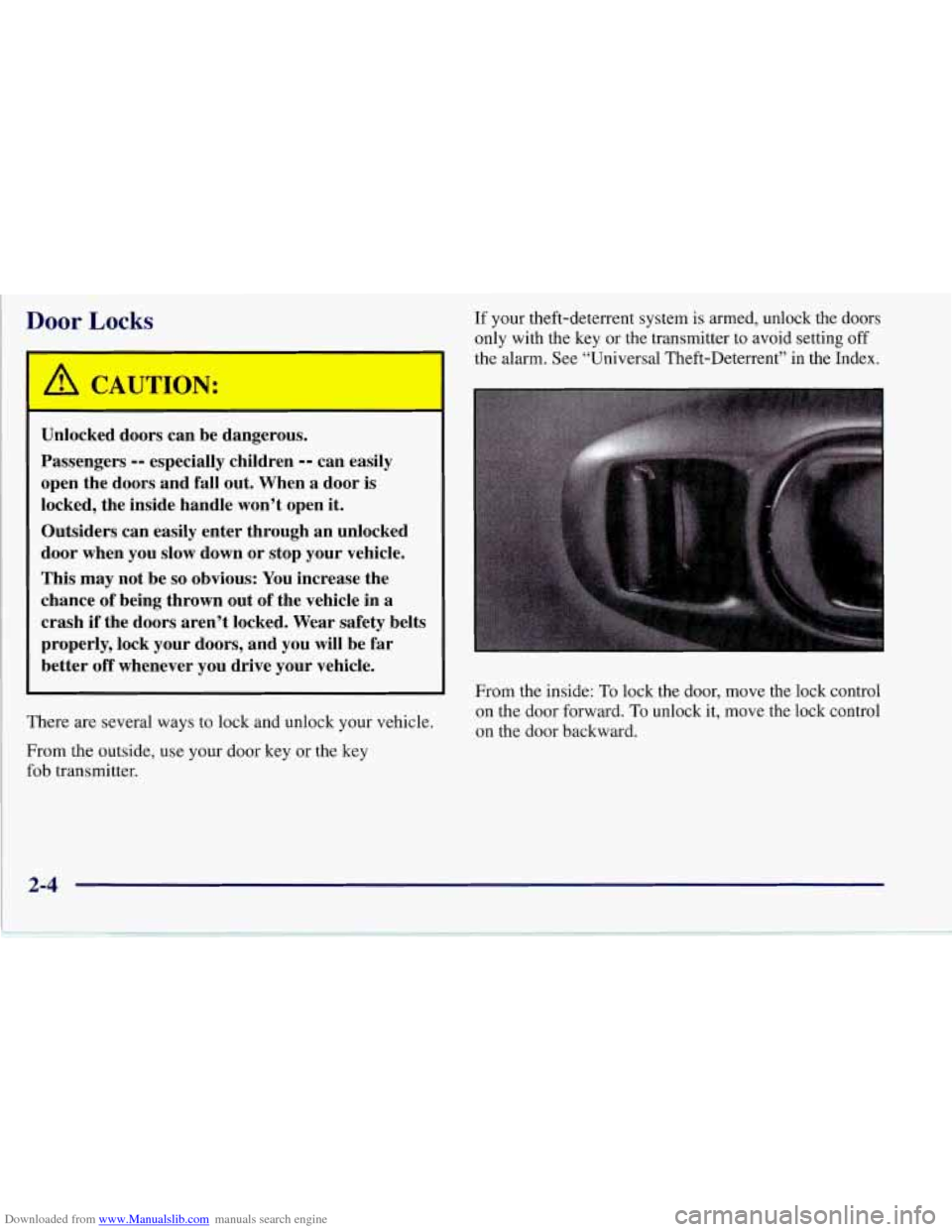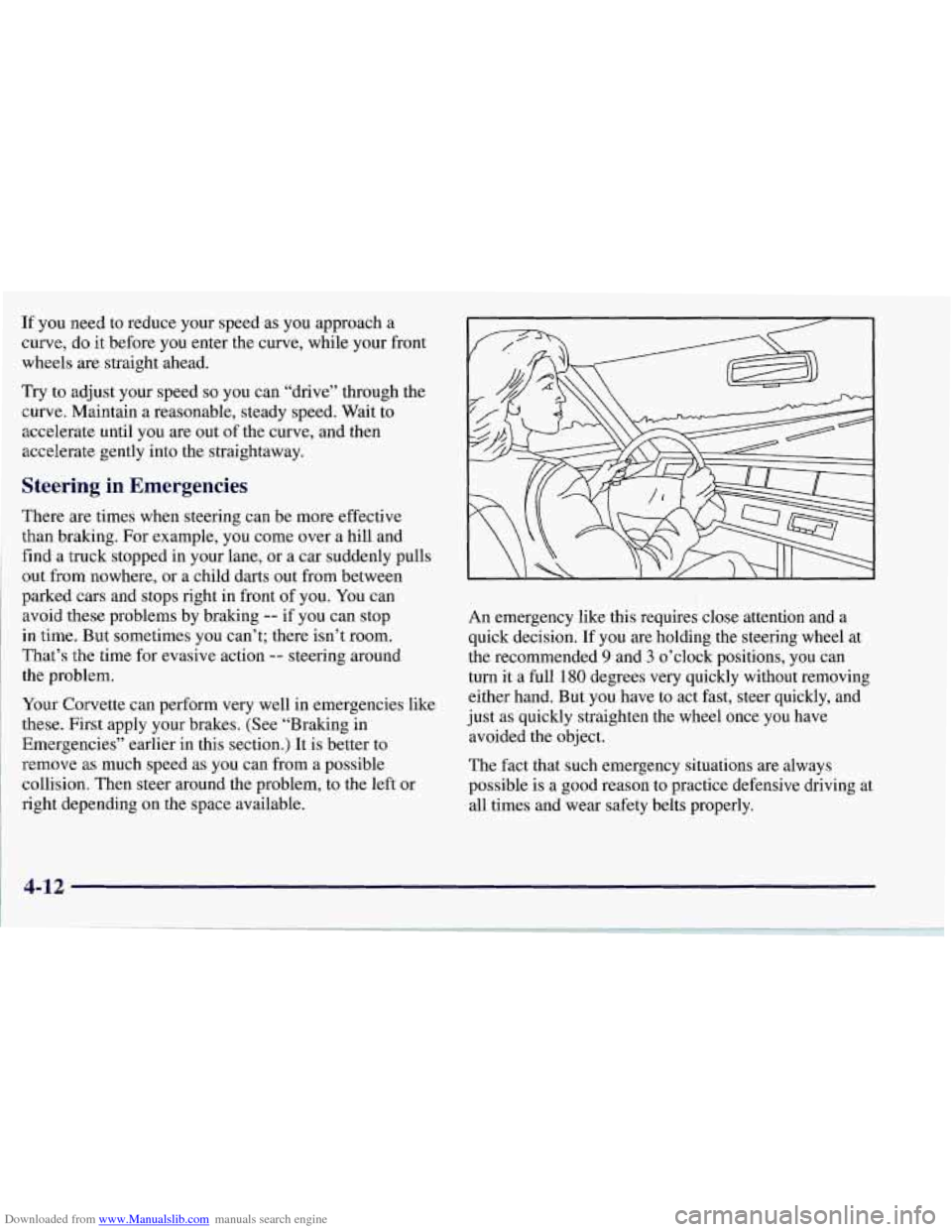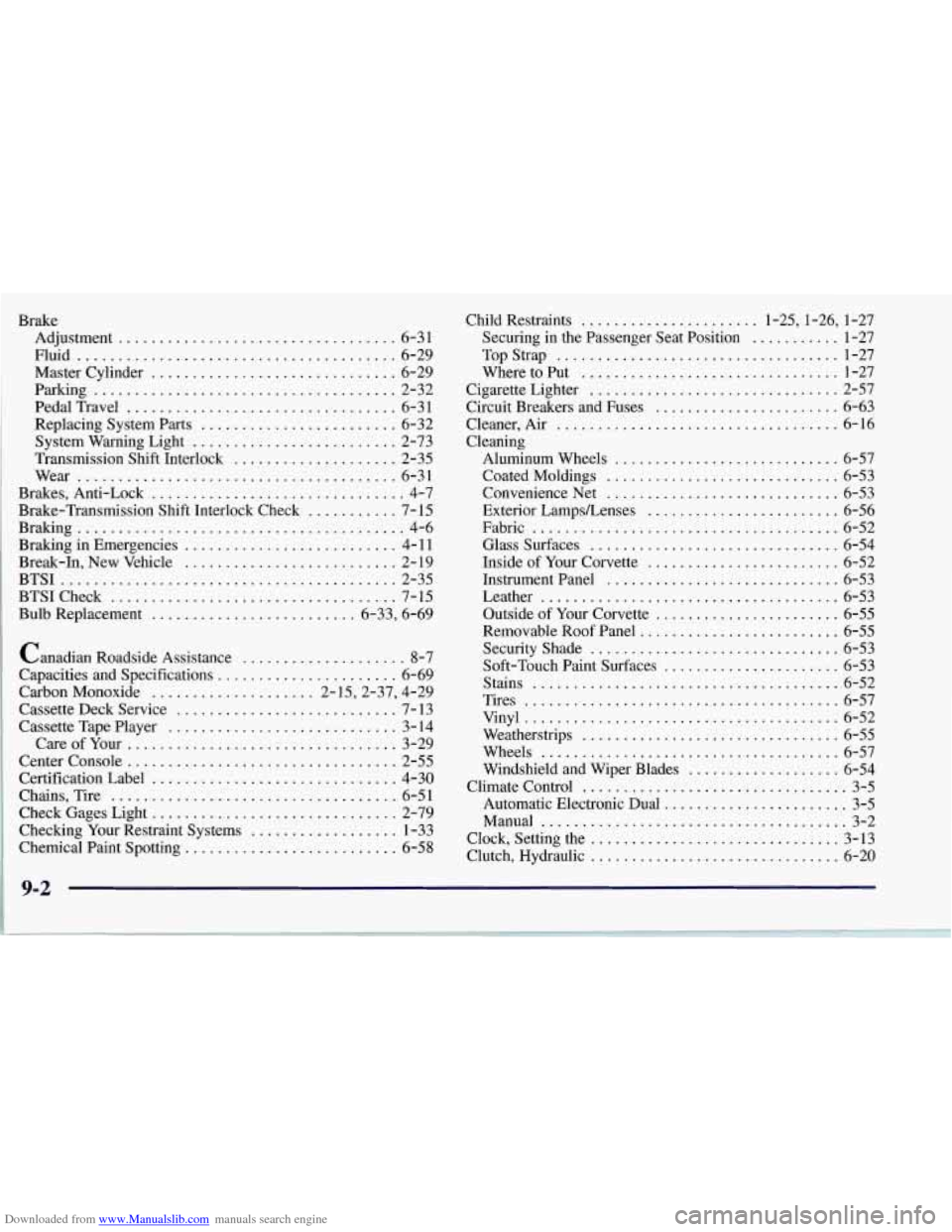Page 53 of 356

Downloaded from www.Manualslib.com manuals search engine Door Locks
A CAUTION:
Unlocked doors can be dangerous.
Passengers
-- especially children -- can easily
open the doors and fall out. When a door is
locked, the inside handle won’t open it.
Outsiders can easily enter through an unlocked
door when you slow down or stop your vehicle.
This may not be
so obvious: You increase the
chance
of being thrown out of the vehicle in a
crash if the doors aren’t locked. Wear safety belts
properly, lock your doors, and you will be
far
better off whenever you drive your vehicle.
There are several ways to lock and unlock your vehicle.
From the outside, use your door key or the key
fob transmitter. If
your theft-deterrent system is armed, unlock the doors
only with the key or the transmitter to avoid setting off
the alarm. See “Universal Theft-Deterrent” in the Index.
From the inside: To lock the door, move the lock control
on the door forward. To unlock it, move the lock control
on the door backward.
Page 191 of 356

Downloaded from www.Manualslib.com manuals search engine If you need to reduce your speed as you approach a
curve,
do it before you enter the curve, while your front
wheels
are straight ahead.
Try to adjust your speed so you can “drive” through the
curve. Maintain a reasonable, steady speed. Wait to
accelerate until you
are out of the curve, and then
accelerate gently into the straightaway.
Steering in Emergencies
There are times when steering can be more effective
than braking. For example, you come over a hill and
find
a truck stopped in your lane, or a car suddenly pulls
out from nowhere, or a child darts out from between
parked cars and stops right in front of you. You can
avoid
these problems by braking -- if you can stop
in time. But sometimes you can’t; there isn’t room.
That’s the time for evasive action
-- steering around
the problem.
Your Corvette can perform very well in emergencies like
these. First apply your brakes. (See “Braking in
Emergencies” earlier in this section.) It
is better to
remove as much speed as you can from a possible
collision. Then steer around the problem, to the left or
right depending on
the space available. An emergency like this
requires close attention and a
quick decision.
If you are holding the steering wheel at
the recommended
9 and 3 o’clock positions, you can
turn it a full
180 degrees very quickly without removing
either hand. But you have to act fast, steer quickly, and
just as quickly straighten the wheel once you have
avoided the object.
The fact that such emergency situations are always
possible is a good reason to practice defensive driving at
all times and wear safety belts properly.
Page 345 of 356

Downloaded from www.Manualslib.com manuals search engine Brake Adjustment
.................................. 6-31
Master Cylinder
.............................. 6-29
Parking
..................................... 2-32
PedalTravel
................................. 6-31
Replacing System Parts
........................ 6-32
System Warning Light
......................... 2-73
Brakes.Anti -Lock
............................... 4-7
Braking in Emergencies
.......................... 4- 11
Break-In. New Vehicle .......................... 2- 19
BTSI
......................................... 2-35
BTSICheck
................................... 7-15
Bulb Replacement
......................... 6.33. 6.69
Fluid
....................................... 6-29
Transmission Shift Interlock
.................... 2-35
Wear
....................................... 6-31
Brake-Transmission Shift Interlock Check
........... 7- 15
Braking
........................................ 4-6
Canadian Roadside Assistance
.................... 8-7
Capacities and Specifications
...................... 6-69
Carbon Monoxide
.................... 2.15.2.37. 4.29
Cassette Deck Service
........................... 7- 13
Cassette Tape Player
............................ 3- 14
Careofyour
................................. 3-29
Center Console
................................. 2-55
Certification Label
.............................. 4-30
Chains. Tire
................................... 6-51
Check Gages Light
.............................. 2-79
Checking Your Restraint Systems
.................. 1-33
Chemical Paint Spotting
.......................... 6-58 Child Restraints
...................... 1.25. 1.26.
1-27
Securing in the Passenger Seat Position
........... 1-27
Top Strap
................................... 1-27
Where to Put
................................ 1-27
Cigarette Lighter
............................... 2-57
Circuit Breakers and Fuses
....................... 6-63
Cleaner. Air
................................... 6-16
Cleaning Aluminum Wheels
............................ 6-57
Coated Moldings
............................. 6-53
Convenience Net
............................. 6-53
Exterior LampsLenses
........................ 6-56
Fabric
...................................... 6-52
Glasssurfaces
............................... 6-54
Inside of Your Corvette
........................ 6-52
Instrument Panel
............................. 6-53
Leather
..................................... 6-53
Outside of Your Corvette
....................... 6-55
Removable Roof Panel
......................... 6-55
SecurityShade
............................... 6-53
Soft-Touch Paint Surfaces
...................... 6-53
Stains
...................................... 6-52
Tires
....................................... 6-57
Vinyl
....................................... 6-52
Weatherstrips
................................ 6-55
Wheels
..................................... 6-57
Windshield and Wiper Blades
................... 6-54
Climate Control
................................. 3-5
Automatic Electronic Dual
....................... 3-5
Manual
...................................... 3-2
Clock. Setting the
............................... 3-13
Clutch. Hydraulic
............................... 6-20
9-2
......... . .... .. ..... ,